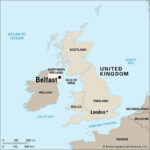Grizzly bears, scientifically known as Ursus arctos horribilis, are magnificent creatures that evoke both awe and respect. A subspecies of the brown bear, the name “grizzly” itself refers to their grizzled, silver-tipped fur, though it’s often mistakenly associated with “grisly,” meaning horrible. Understanding where these powerful animals roam is crucial to appreciating their place in the natural world and the importance of their conservation. So, Where Are Grizzly Bears Found?
Grizzly bears are renowned for their impressive size and a distinctive hump located between their shoulders, a mass of muscle that contributes to their digging power. Their coloration is typically dark brown, but it can vary widely from blond to even black. Adult males are significantly larger than females, weighing anywhere from 300 to 800 pounds, while females typically range from 200 to 450 pounds. When standing on their hind legs, some male grizzlies can reach an imposing height of eight feet. This size and strength are perfectly adapted to the diverse environments they inhabit.
Currently, grizzly bears are primarily found in the wilder regions of North America. Their strongholds are concentrated in:
- Alaska: Alaska boasts a significant grizzly bear population, thriving across vast stretches of wilderness.
- Wyoming, Montana, and Idaho: These states within the contiguous United States are home to notable grizzly populations, particularly around the Greater Yellowstone Ecosystem and Glacier National Park areas.
- Washington: A smaller population exists in certain areas of Washington state.
- Possibly Southern Colorado: While less confirmed, there are occasional reports and ongoing discussions regarding the potential presence or re-establishment of grizzlies in southern Colorado.
- Western Canada: Grizzly bears are widespread throughout western Canada, including provinces like British Columbia, Alberta, Yukon, and Northwest Territories.
Historically, the range of grizzly bears was far more extensive. They once roamed from Alaska all the way south to Mexico and stretched eastward from the Pacific Ocean to the Mississippi River. This vast historical range encompassed a diverse array of habitats. However, westward expansion and human encroachment led to a drastic reduction in their numbers and territory.
Grizzly bears are remarkably adaptable animals, thriving in a variety of habitats. Their adaptability is a key reason why they can be found in diverse locations within their current range. These habitats include:
- High Mountain Forests: They are well-suited to the rugged terrain and forested areas of mountainous regions.
- Subalpine Meadows: These grassy areas at high elevations provide crucial foraging opportunities, especially during summer months.
- Arctic Tundra: In the northern reaches of their range, grizzlies inhabit the open, treeless landscapes of the arctic tundra.
- Wetlands: Wetland areas offer rich food sources, including vegetation and prey animals.
- Grasslands: Grizzlies can also be found in grasslands, where they forage for roots, bulbs, and small mammals.
- Mixed-Conifer Forests: These forests, with a mix of coniferous trees, provide both cover and food resources.
- Coastal Areas: In coastal regions, particularly in Alaska and Canada, grizzly bears are known to frequent areas where salmon spawn, providing a vital seasonal food source.
While grizzly bears do not migrate in the traditional sense of seasonal mass movements, they do exhibit dispersal and seasonal movements. Instead of migrating, grizzlies hibernate during the winter months. Males may disperse to establish new territories or reclaim areas, sometimes traveling considerable distances. Females are believed to disperse over shorter distances. The size of a grizzly bear’s territory is largely influenced by food availability; areas with higher food density generally support smaller territories. They are capable of traveling dozens of miles in search of food or mates.
Grizzly bears are omnivores with a highly varied diet. They are opportunistic feeders, consuming “just about anything.” This includes:
- Insects: From ants to bees, insects are a protein source, especially in certain seasons.
- Berries: A wide variety of berries are consumed when in season, providing essential sugars and nutrients.
- Nuts: Nuts, when available, offer a high-energy food source.
- Bulbs and Roots: They use their powerful claws to dig up bulbs and roots.
- Carrion: They readily scavenge carcasses of dead animals.
- Fish: Salmon is a crucial food source for grizzlies in Alaska and Canada during spawning season.
- Small Mammals: They hunt or dig for subterranean mammals.
- Army Cutworm Moths: Remarkably, in areas like Yellowstone, grizzlies can consume thousands of army cutworm moths daily during summer, representing a significant protein intake.
Grizzlies are known to cache carrion, covering it with grass and moss, effectively preserving it for later consumption.
Despite their adaptability, grizzly bears face numerous threats, primarily stemming from human activities. Habitat degradation due to development, logging, road construction, oil and gas drilling, livestock grazing, and other forms of resource exploitation are major concerns. Predator control measures also pose a significant threat. Furthermore, climate change is exacerbating threats, as seen in the decline of whitebark pine nuts, a key food source in the Yellowstone region, due to pine bark beetle infestations linked to warmer temperatures.
The population trend for grizzly bears reflects a dramatic decline from their historical numbers. Between 1850 and 1970, they were eliminated from an estimated 98 percent of their original range. Populations plummeted from a high of approximately 50,000 to a mere 1,500 to 1,700. This drastic decline led to their listing as threatened under the Endangered Species Act in the contiguous United States in 1975. Conservation efforts are crucial to ensure that grizzly bears continue to roam the wild landscapes where they are found today and to potentially facilitate their recovery and expansion into suitable habitats in the future.

